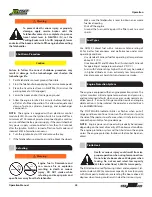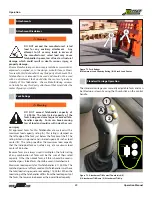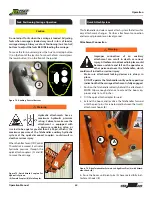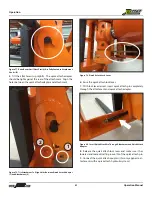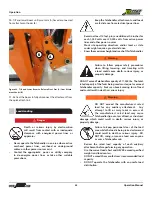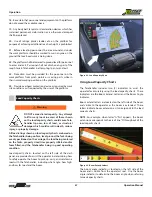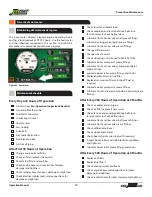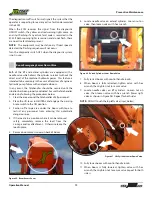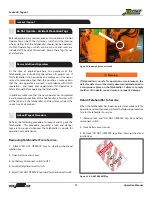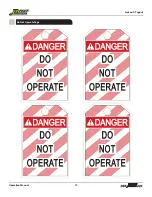
Operation Manual
68
Operation
NOTE: The boom angle indicator is a plumb arrow with
angular graduations from -50 to +700.
Figure 90. Boom Angle Indicator.
Reading Load Capacity Charts
To accurately read the load capacity charts, you must
determine three (3) things:
•
Weight of the load being lifted
•
Height of structure where load is to be placed
•
Distance from front tires where load will be placed
For example:
1.
The operator determines load weight and makes sure load
does not exceed fork, attachment, or boom capacity.
The load is 3,000 lbs.
2.
The operator safely moves the load to a loading position.
•
Places forks under load
•
Tilts and raises load safely
•
Fully retracts boom
•
Drives Telehandler to position perpendicular to structure
•
Levels the Telehandler
3.
The operator determines height of structure where load is
to be placed.
The structure height is 30 feet from ground level.
4.
The operator determines distance from front tires where
load will be placed.
The distance in front of Telehandler where load will be placed
is 20 feet.
5.
Operator reads load capacity chart for attachment carriage
to learn it will be safe to place the load at any boom angle with
the boom extend letter “E” showing.
Figure 91. Load Capacity
Chart.
NOTE: The boom angle indicator is a plumb arrow with
angular graduations from -50 to +700.
0
5
10
15
20
25
30
35
REACH (FT)
HEIGHT (FT) 0
5
10
15
20
25
30
35
40
45
50
55
A
B
C
D
E
F
G
H
A
B
C
D
E
F
G
H
-8°
20°
25°
30°
35°
40°
45°
50°
55°
70°
60°
65°
0°
5°
10°
15°
BOOM ANGLE
1,800 LBS
2,500 LBS
3,500 LBS
5,500 LBS
8,300 LBS 9,500 LBS
10,000 LBS 11,000 LBS
OPERATION ABOVE
40
DEGREES WITH
AXLE
LOCKED ONLY
2.0 FT
LOAD
CENTER
2.0 FT
LOAD
CENTER
XR1147 LOAD CHART
STANDARD CARRIAGE
P/N 17412-000
NO OPERATION ABOVE
40 DEGREES BOOM
ANGLE WITH REAR AXLE
UNLOCKED.
LOAD RATINGS ARE FOR
VEHICLE EQUIPPED WITH
FOAM FILLED
OR SOLID TIRES.
LOAD RATING INCLUDES
WEIGHT OF ANY RIGGING
5,500 LBS AT 24 IN
MIN CAPACITY FORK
(11,000 LBS PAIR).





